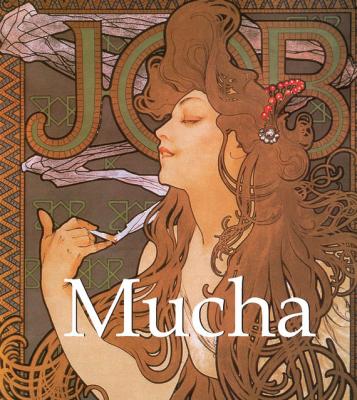Mucha. Patrick Bade
Читать онлайн.| Название | Mucha |
|---|---|
| Автор произведения | Patrick Bade |
| Жанр | Иностранные языки |
| Серия | Mega Square |
| Издательство | Иностранные языки |
| Год выпуска | 0 |
| isbn | 978-1-78160-979-8, 978-1-78042-230-5 |
“The poster is going to get people talking about new modes of expression towards a public that is not only aristocratic any more. It will be made to be seen by everyone”.
© Confidential Concepts, worldwide, USA
© Parkstone Press International, New York, USA
© Mucha Estate / Artists Rights Society, New York, USA / ADAGP, Paris
Biography
1860
Alphonse Mucha is born on the 14th July in Ivancice, Moravia, a province of the Austro-Hungarian Empire. He is the son of a court usher and is brought up in keeping with the virtues of nationalism. He begins to draw at a young age.
1871
Mucha is a chorister at the Saint-Peter’s Cathedral in Brno, where he receives his secondary school education. It is there that he has his first revelation, in front of the richness of Baroque art. During the four years of studying there, he forms a friendship with Leos Janácek who would become the greatest Czech composer of his generation.
1877
He fails to enter the Academy of Art in Prague.
1879
Mucha finds work as an auxiliary in a firm of theatre designers in Vienna.
1881
Following a fire which ravages the Ringtheatre (the main client of the firm where he works) Mucha is dismissed from his job as a designer. He settles in the small town of Mikulov where he draws portraits. There he meets his first patron, Count Khuen, who invites him to decorate his castle with painted murals.
1884
Mucha studies art in Munich whilst carrying out work for Count Egon, brother of Count Khuen, in Tyrol.
1888
He moves to Paris, a city excited at the forthcoming Exposition Universelle.
Mucha enters the Julian Academy where he meets the Nabis group: Sérusier, Vuillard, Bonnard and Denis, but also Gauguin, with whom he shares a studio in 1893. He joins the Symbolist movement led by Puvis de Chavannes, Redon, Moreau and Huysmans.
1889
He draws his first illustrations for the reviews.
1894
Mucha creates Gismonda, his first poster for the actress Sarah Bernhardt and enters into a six-year contract with her. This turning point in his life puts him on the path to a career in decorating boards.
1900
He plans different pavilions for the Exposition Universelle, among which is the Bosnian-Herzegovinian. He works at the same time for Fouquet jewellers. This brings him projects for his boutique.
1904
Mucha leaves to settle in the United States.
1913
He returns definitively to his homeland and decides to dedicate himself to the painting of patriotic frescoes and to elaborate a collection named The Slav Epic.
1928
Mucha donates the twenty paintings of The Slav Epic to the Czech people and the City of Prague.
1936
An exhibition is dedicated to him as well as to his compatriot Frantisek Kupka at the Real Games Gallery.
1939
Alphonse Mucha dies of pneumonia on the 14th of July.
Since the Art Nouveau revival of the 1960s, when students around the world adorned their rooms with reproductions of Mucha posters of girls with tendril-like hair and the designers of record sleeves produced Mucha imitations in hallucinogenic colours, Alphonse Mucha’s name has been irrevocably associated with the Art Nouveau style and with the Parisian fin-de-siècle.
Gismonda
1894
Colour lithograph, 216 × 74.2 cm.
Mucha Museum, Prague.
Artists rarely like to be categorised and Mucha would have resented the fact that he is almost exclusively remembered for a phase of his art that lasted barely ten years and that he was regarded as of lesser importance. As a passionate Czech patriot he would have also been unhappy to be regarded as a “Parisian” artist.
La Dame aux camélias
1896
Colour lithograph, 205 × 72 cm.
Richard Driehaus, Chicago.
Mucha was born on July 14, 1860 at Ivancice in Moravia, then a province of the vast Habsburg Empire. It was an empire that was already splitting apart at the seams under the pressures of the burgeoning nationalism of its multi-ethnic component parts. In the year before Mucha’s birth, nationalist aspirations throughout the Habsburg Empire were encouraged by the defeat of the Austrian army in Lombardy that preceded the unification of Italy.
Journée Sarah (La Plume)
1896
Colour lithograph, 69 × 50.8 cm
Posters Please Inc., New York.
In the first decade of Mucha’s life Czech nationalism found expression in the orchestral tone poems of Bedrich Smetana that he collectively entitled “Ma Vlast” (My country) and in his great epic opera “Dalibor” (1868). It was symptomatic of the Czech nationalist struggle against the German cultural domination of Central Europe, in that the text of “Dalibor” had to be written in German and translated into Czech.
Biscuits Champagne Lefèvre-Utile
1896
Colour lithograph, 51.4 × 32 cm.
Mucha Trust.
From his earliest days Mucha would have imbibed the heady and fervent atmosphere of Slav nationalism that pervades “Dalibor” and Smetana’s subsequent pageant of Czech history, “Libuse”, which was used to open the Czech National Theatre in 1881 and for which Mucha himself would later provide set and costume designs.
Cassan Fils
1896
Colour lithograph, 203.7 × 76 cm.
Mucha Trust.
Mucha’s born into relatively humble circumstances, as the son of a court usher. His own son, Jiri Mucha, would later proudly trace the presence of the Mucha family in the town of Ivancice back to the fifteenth century. If his family was poor, Mucha’s upbringing was nevertheless abundant with artistic stimulation and encouragement.
Self Portrait
1899
Oil on cardboard, 21 × 32 cm.
Mucha Museum, Prague.
According to his son Jiri, “He drew even before he learnt to walk and his mother would tie a pencil round his neck with a coloured ribbon so that he could draw as
